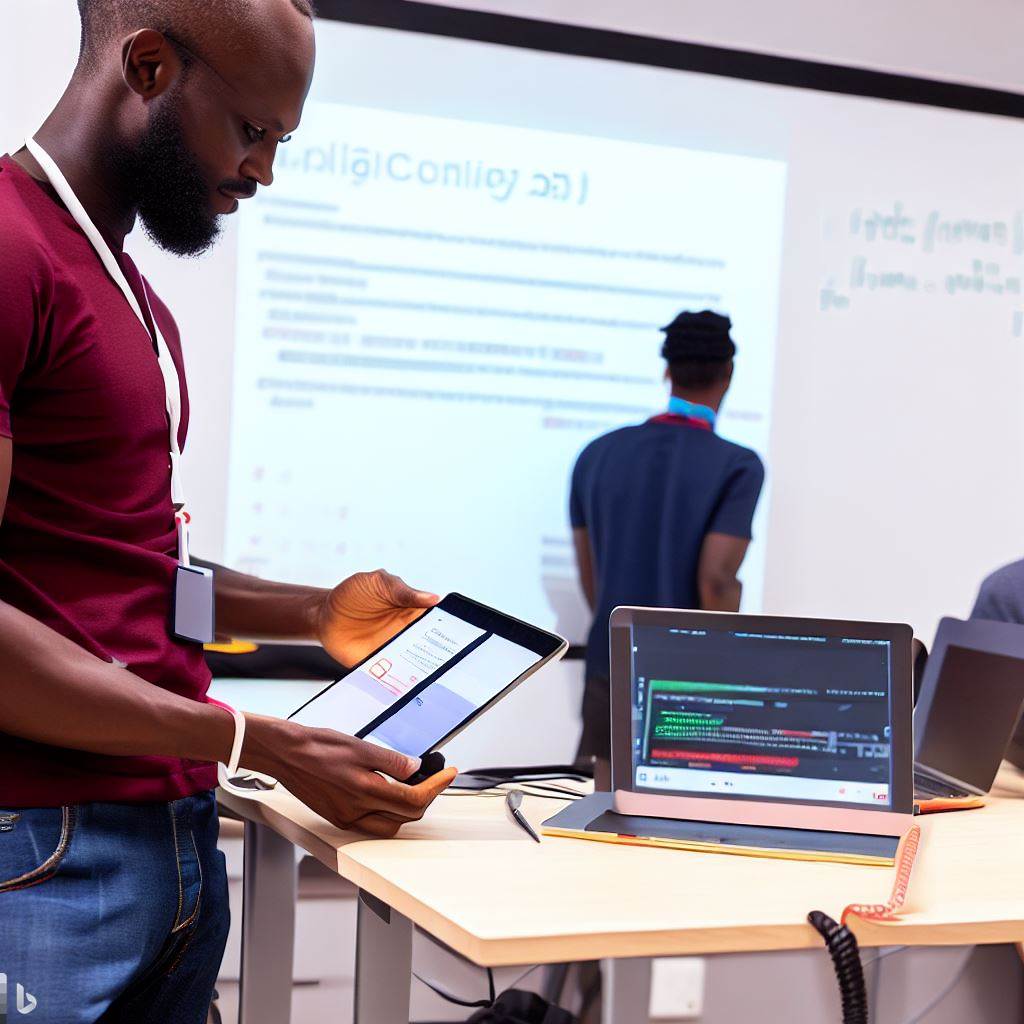Introduction
Coding schools have become increasingly important in today’s digital age. In this blog section, we will explore the future of learning within coding schools.
The importance of coding schools cannot be overstated in our rapidly advancing digital world.
These educational institutions play a crucial role in preparing individuals for technology-driven careers.
As technology continues to evolve at a staggering pace, there is a growing demand for skilled coding professionals.
Transitioning from the significance of coding schools, we now shift our focus towards the future of learning within these institutions.
With advancements in technology, coding schools must adapt to meet the changing needs of learners. Traditional classroom settings may no longer be sufficient to provide the necessary skills and knowledge.
Coding schools are embracing innovative teaching methods to enhance the learning experience. They are increasingly utilizing online platforms, virtual reality, and interactive coding tools.
This shift allows students to learn at their own pace, collaborate with peers, and gain real-world coding experience.
This approach enables students to apply coding concepts to real-world scenarios, enhancing their problem-solving abilities and creativity.
By learning through practical projects, students can build a strong portfolio to showcase their skills to potential employers.
In addition to these pedagogical changes, coding schools are also focusing on incorporating soft skills development into their curricula.
The ability to communicate effectively, collaborate, and think critically are invaluable skills in the modern workplace.
By nurturing these skills, coding schools are equipping students with a well-rounded set of abilities.
Current State of Coding Schools
Overview of the current popularity and success of coding schools
- Coding schools have gained immense popularity in recent years due to the increasing demand for tech skills.
- These schools offer intensive, short-term programs that promise to teach coding skills quickly and effectively.
- Many people are opting for coding schools as an alternative to traditional four-year degrees in computer science.
- Coding schools have seen tremendous success with high job placement rates and successful career transitions for graduates.
- The popularity of coding schools is evident in the rising number of students enrolling in such programs.
Discussion of the advantages and limitations of traditional coding education
- Traditional coding education, such as pursuing a computer science degree, provides a comprehensive understanding of programming concepts.
- However, traditional education is time-consuming and expensive compared to coding schools.
- Coding schools, on the other hand, offer a focused curriculum that is relevant to the current industry needs.
- The fast-paced nature of coding schools allows students to learn practical skills faster and enter the job market quickly.
- One limitation of traditional education is that it may not always keep up with the rapidly changing technology landscape.
Introduction of emerging trends shaping the future of coding schools
- Online coding schools and bootcamps are gaining traction, providing flexible learning options for those unable to attend physical classes.
- The demand for specialized coding skills, such as data science and cybersecurity, is driving the emergence of coding schools catering to these areas.
- Coding schools are partnering with companies to offer job guarantees and internships, enhancing the students’ career prospects.
- Personalized learning models, utilizing AI and adaptive learning platforms, are being explored to create tailored coding programs.
- Coding schools are incorporating hands-on, project-based learning to ensure students gain practical experience.
Coding schools have become a popular choice for individuals seeking quick and focused coding education.
However, traditional education still has its merits and provides a comprehensive understanding of coding concepts.
Tech Consulting Tailored to Your Coding Journey
Get expert guidance in coding with a personalized consultation. Receive unique, actionable insights delivered in 1-3 business days.
Get StartedIn the future, emerging trends like online learning, specialized programs, and personalized learning models will shape the coding school landscape.
Technological Advancements Enhancing Learning
Exploration of emerging technologies facilitating learning in coding schools
- Gamification and interactive platforms.
- Virtual reality (VR) and augmented reality (AR) in coding education.
- Artificial intelligence (AI) and machine learning applications.
Examples of coding schools already implementing these technologies
Innovative coding schools are already utilizing emerging technologies to enhance the learning experience. For example:
- Codecademy has incorporated gamification into its platform, turning coding education into an engaging and interactive experience.
- General Assembly offers virtual reality coding courses, enabling students to immerse themselves in virtual coding environments for hands-on learning.
- CodinGame employs artificial intelligence to create personalized learning paths for its users, providing individualized guidance based on their skill levels.
Benefits and potential challenges associated with technological advancements
There are several advantages and potential hurdles to consider when incorporating these technological advancements into coding schools.
Benefits include:
- Increased student engagement and motivation through gamification and interactive platforms.
- Enhanced learning experiences and improved retention rates with VR and AR technology.
- Efficient and personalized learning paths enabled by AI and machine learning applications.
However, there are also potential challenges to address:
- High implementation costs for coding schools to adopt and maintain these technologies.
- Technological infrastructure requirements to support VR and AR experiences.
- Ensuring the proper training and support for educators to effectively integrate these technologies into the curriculum.
- Potential privacy and security concerns with AI and machine learning applications.
In fact, the future of coding schools is intertwined with technological advancements.
The exploration of emerging technologies such as gamification, virtual reality, augmented reality, artificial intelligence, and machine learning opens up new possibilities for enhancing learning experiences.
Coding schools, like Codecademy, General Assembly, and CodinGame, are already implementing these technologies to provide students with interactive and personalized learning opportunities.
While there are benefits associated with these advancements, coding schools will also need to overcome challenges related to costs, infrastructure, teacher training, and data security.
Nevertheless, the integration of these technologies holds great potential for shaping the future of learning in coding schools.
Read: File Handling in Python: Reading and Writing Files
Personalized and Adaptive Learning Approaches
Personalized learning and its potential in coding education
Customized curriculum and individualized learning paths allow students to learn at their own pace.
Adaptive assessments and feedback mechanisms provide targeted guidance and support to students.
Personalized learning in coding education offers several advantages
- Increased engagement and motivation as students can tailor their learning to their interests and goals.
- Improved retention and understanding as the curriculum is designed to match each student’s unique learning style.
- Opportunity for mastery-based learning, allowing students to progress based on their proficiency rather than a fixed timeline.
- Enhanced problem-solving and critical thinking skills through personalized challenges and projects.
However, personalized learning also presents some challenges:
Build Your Vision, Perfectly Tailored
Get a custom-built website or application that matches your vision and needs. Stand out from the crowd with a solution designed just for you—professional, scalable, and seamless.
Get Started- Requires significant planning and resources to develop and maintain customized curriculum.
- Demands a high level of teacher/student interaction and individual support.
- May raise concerns about equity and access to personalized technologies and resources.
Examples of coding schools embracing personalized learning approaches
Several coding schools have recognized the potential of personalized learning and have implemented innovative approaches:
- Coding School X offers a self-paced curriculum, allowing students to choose their own learning path and projects.
- Coding School Y utilizes adaptive assessments to identify areas for improvement and provide targeted feedback.
- Coding School Z incorporates personalized coding challenges based on each student’s skill level and progress.
These examples demonstrate how personalized learning can be effectively integrated into coding education, creating a more dynamic and student-centered learning experience.
Collaborative Learning Environments
Importance of Collaborative Learning in Coding Schools
Collaborative learning plays a vital role in coding schools as it fosters teamwork, enhances problem-solving skills, and promotes creativity.
When students work collaboratively, they can share their diverse perspectives, ideas, and experiences.
This type of learning encourages active participation, engagement, and knowledge sharing among students.
It allows them to learn from each other, ask questions, and provide feedback, which accelerates the learning process and improves retention.
Overview of Emerging Collaborative Learning Strategies
1. Project-based Learning and Group Projects
Project-based learning is an effective strategy that coding schools are incorporating into their curriculum. Students collaborate on real-world projects, working together to plan, design, and develop software solutions.
Group projects encourage teamwork, collaboration, and communication. Students can leverage their individual strengths, dividing tasks and responsibilities, to achieve the project objectives.
This approach prepares them for future work environments that emphasize teamwork.
2. Peer Programming and Coding Bootcamps
Peer programming is a popular collaborative learning strategy utilized in coding schools. Students work in pairs or small groups, with one person typing and the other observing, analyzing, and providing real-time feedback.
By working together, students improve their coding skills, problem-solving abilities, and communication. Peer programming also creates an environment of mutual support, where students motivate and challenge each other to excel.
Coding bootcamps emphasize the significance of collaborative learning by offering immersive and intensive learning experiences.
Students collaborate in small groups or cohorts, exchanging knowledge, sharing resources, and troubleshooting coding challenges together.
Case Studies of Coding Schools Implementing Collaborative Learning Environments
Many coding schools have successfully implemented collaborative learning environments, reaping numerous benefits for their students. Let’s explore a few inspiring case studies:
Optimize Your Profile, Get Noticed
Make your resume and LinkedIn stand out to employers with a profile that highlights your technical skills and project experience. Elevate your career with a polished and professional presence.
Get NoticedCase Study 1: Tech Academy
Tech Academy, a renowned coding school, incorporates collaborative learning through pair programming sessions and group projects.
Students work together on software development projects, enhancing their coding skills and collaborative capabilities.
Case Study 2: Hack Reactor
Hack Reactor, another leading coding school, places a strong emphasis on collaborative learning.
They organize coding bootcamps where students work intensively in groups, fostering collaborative problem-solving and enhancing teamwork skills.
Case Study 3: Flatiron School
Flatiron School is a coding school that implements project-based learning.
Students collaborate on real-world coding projects, simulating a professional work environment and building essential teamwork and communication skills.
Generally, collaborative learning environments hold immense importance in coding schools.
They promote teamwork, problem-solving, and creativity while providing students with real-world experiences.
Implementing emerging collaborative learning strategies like project-based learning, peer programming, and coding bootcamps can significantly enhance the learning experience in coding schools.
Read: Teaching Python to Kids: A Comprehensive Guide for Parents

Industry-Relevant Skills and Focus
Exploration of the Importance of Industry-Relevant Skills in Coding Schools
Coding schools have recognized the significance of industry-relevant skills in preparing students for the future.
By focusing on these skills, coding schools ensure that graduates have the necessary tools to succeed.
Employers today are looking for candidates who possess practical knowledge and hands-on experience.
Coding schools that prioritize industry-relevant skills increase the employability of their graduates.
Discussion of Emerging Skills and Knowledge Areas in Demand
As technology continuously evolves, new skills and knowledge areas become highly sought after in the industry.
- Data Science and Analytics: In today’s data-driven world, professionals with expertise in data science and analytics are in high demand. Companies need individuals who can extract insights from vast amounts of data to drive informed decision-making.
- Cybersecurity and Ethical Hacking: The increasing number of cyber threats has led to a rise in demand for cybersecurity professionals. Coding schools are adapting their curriculum to address the need for ethical hackers and experts in securing digital systems.
- Internet of Things (IoT) and Blockchain Technologies: The IoT and blockchain technologies are revolutionizing various industries. Coding schools are incorporating these technologies into their programs to meet the growing demand.
Examples of Coding Schools Adapting Their Curriculum to Align with Industry Needs
Leading coding schools have recognized the need to adapt their curriculum to align with industry demands.
General Assembly, one of the most prevalent coding schools, regularly updates its courses to match changing trends.
Flatiron School offers a comprehensive cybersecurity program to equip students with in-demand skills.
App Academy focuses on teaching web development and data science, areas that are highly sought after by employers.
Hack Reactor, another reputable coding school, collaborates with industry experts to develop relevant curriculum and projects.
Through these examples, it is evident that coding schools are proactive in catering to industry needs.
By staying up-to-date with emerging trends, they can provide students with valuable skills that employers desire.
Coding schools understand that the future of learning lies in preparing students with industry-relevant knowledge.
As the needs of the job market evolve, coding schools continue to adapt their curriculum accordingly.
By doing so, they ensure that their graduates can thrive in an ever-changing technological landscape.
The future of learning in coding schools revolves around industry-relevant skills and knowledge.
As the demand for specific areas like data science, cybersecurity, and IoT grows, coding schools must adapt.
By aligning their curriculum with industry needs, coding schools enhance the employability and success of their graduates.
Through continuous adaptation, coding schools can provide students with the tools to excel in their future careers.
It is imperative for coding schools to embrace the dynamic nature of the industry to prepare the digital workforce effectively.
Read: Why Coding Skills are Essential for Kids’ Future Success
Remote and Online Learning Opportunities
Overview of the growth of remote and online learning in coding education
- Remote and online learning in coding education has witnessed significant growth in recent years.
- Advancements in technology have made it easier for individuals to access coding courses remotely.
- Coding schools now offer comprehensive online programs that cater to learners’ needs.
- This growth has allowed coding education to reach a wider audience and break geographical barriers.
- Moreover, the flexibility of remote learning enables students to learn at their own pace.
- Students can access coding materials and resources from anywhere with an internet connection.
- Online coding platforms provide interactive tools and support for hands-on practice and collaboration.
- Overall, the growth of remote and online learning has revolutionized coding education.
Advantages and disadvantages of remote and online learning in coding schools
Advantages
- Flexible scheduling allows learners to balance coding education with other commitments.
- Lower costs compared to traditional in-person coding schools due to reduced overhead expenses.
- Access to a broader range of coding courses and instructors, regardless of geographical location.
- Ability to learn at an individualized pace, accelerating progress or reviewing concepts as needed.
- Self-paced learning promotes independent problem-solving and boosts self-discipline.
- Remote learning provides a comfortable and familiar environment for individuals, reducing stress.
Disadvantages
- Lack of face-to-face interaction and immediate support from instructors may hinder some learners.
- Technical issues and connectivity problems can interrupt the learning process.
- Isolation and reduced social interaction may affect motivation and collaborative skills.
- Self-motivation and time management skills are crucial to succeed in remote learning.
- Remote learning requires strong discipline, as there are fewer external accountabilities.
Successful coding schools offering remote and online programs
- General Assembly is a well-established coding school that offers remote and online coding programs.
- Bloc.io provides immersive online coding bootcamps with mentorship and tailored curriculum.
- Flatiron School offers online coding programs designed for career changers and tech enthusiasts.
- Thinkful delivers flexible coding education with one-on-one mentorship and career services.
- Coding Dojo provides remote and online coding courses with a focus on multiple programming languages.
In short, remote and online learning opportunities have become an essential part of coding education.
They have expanded access, flexibility, and affordability while transforming the traditional learning landscape.
While there are advantages and disadvantages to remote learning, successful coding schools have embraced this trend.
As technology continues to advance, it is clear that remote and online learning will play a significant role in the future of coding education.
Read: 5 Best Coding Apps for Kids: Turn Screen Time into Learning
Conclusion
In summary, the future of coding schools is evolving rapidly. We have seen an increasing emphasis on practical skills, immersive learning experiences, and personalized education.
The rise of online platforms and bootcamps has also democratized access to coding education.
Coding schools must now adapt to these changing trends in order to remain relevant.
They should focus on providing hands-on projects, mentorship programs, and career services to ensure that students are well-prepared for the workforce.
Additionally, schools need to embrace emerging technologies, such as artificial intelligence and machine learning, to stay ahead of the curve.
The future of coding schools is full of immense potential. As technology continues to advance, the demand for coding skills will only increase.
By embracing innovative teaching methods and incorporating new technologies, coding schools have the opportunity to shape the future of education and empower individuals to thrive in the digital age.




